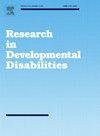The effectiveness of an individualised and adaptive game-based rehabilitation, iVision, on visual perception in cerebral visual impairment: A triple-blind randomised controlled trial
IF 2.9
2区 医学
Q1 EDUCATION, SPECIAL
引用次数: 0
Abstract
Background
Cerebral visual impairment (CVI) can negatively affect a child’s functioning, emphasising the need for interventions to improve visual perception (VP), potentially translating into improved health-related quality of life (HRQOL).
Aims
Assessing the effectiveness of an adaptive individualised game-based rehabilitation, iVision, on VP, visual function, functional vision, and HRQOL.
Methods and procedures
Seventy-three children with CVI (3–12 performance age) were randomised into the adaptive individualised or the non-adaptive non-individualised group (3 sessions/week; 12 weeks). Primary outcome was change score (post-intervention – pre-intervention) of the lowest VP dimension. Key secondary outcomes included change score (post-intervention – pre-intervention) of visual function (reaction time to fixation in a preferential looking eye-tracking paradigm), functional vision (success rate in the adapted virtual toy box paradigm; total Flemish CVI questionnaire score), HRQOL (total scale score of the paediatric quality of life inventory 4.0 child self-report), and the lowest VP dimension change score (short-term follow-up – pre-intervention).
Outcomes and results
Both groups significantly improved on the primary outcome, maintaining at short-term. Between-group differences were not significant. No significant effect was found for other key secondary outcomes. Exploratory analyses revealed VP dimension improvements and clinically meaningful HRQOL improvements.
Conclusions and implications
Although children with CVI improved their VP and to some extent HRQOL, no differences were found between the groups.
基于个性化和适应性游戏的康复,iVision,对脑视觉障碍患者视觉感知的有效性:一项三盲随机对照试验。
背景:脑视觉障碍(CVI)会对儿童的功能产生负面影响,强调需要采取干预措施改善视觉感知(VP),可能转化为改善健康相关生活质量(HRQOL)。目的:评估自适应个性化游戏康复,iVision,对VP,视觉功能,功能性视觉和HRQOL的有效性。方法和程序:73例CVI患儿(3-12岁)随机分为适应性个体化治疗组和非适应性非个体化治疗组(3次/周;12周)。主要结果为最低VP维度的改变得分(干预后-干预前)。主要的次要结果包括视觉功能的变化得分(干预后-干预前)(在优先注视的眼动追踪范式中对注视的反应时间),功能视觉(适应性虚拟玩具盒范式中的成功率;佛兰芒CVI问卷总分)、HRQOL(儿童生活质量量表4.0儿童自述总分)、最低VP维度改变得分(短期随访-干预前)。结果和结果:两组的主要结果均有显著改善,短期维持。组间差异无统计学意义。其他关键次要结局未发现显著影响。探索性分析显示VP维度的改善和临床意义的HRQOL改善。结论和意义:虽然CVI患儿的VP和HRQOL在一定程度上得到了改善,但两组之间没有发现差异。
本文章由计算机程序翻译,如有差异,请以英文原文为准。
求助全文
约1分钟内获得全文
求助全文
来源期刊

Research in Developmental Disabilities
Multiple-
CiteScore
5.50
自引率
6.50%
发文量
178
期刊介绍:
Research In Developmental Disabilities is aimed at publishing original research of an interdisciplinary nature that has a direct bearing on the remediation of problems associated with developmental disabilities. Manuscripts will be solicited throughout the world. Articles will be primarily empirical studies, although an occasional position paper or review will be accepted. The aim of the journal will be to publish articles on all aspects of research with the developmentally disabled, with any methodologically sound approach being acceptable.
 求助内容:
求助内容: 应助结果提醒方式:
应助结果提醒方式:


